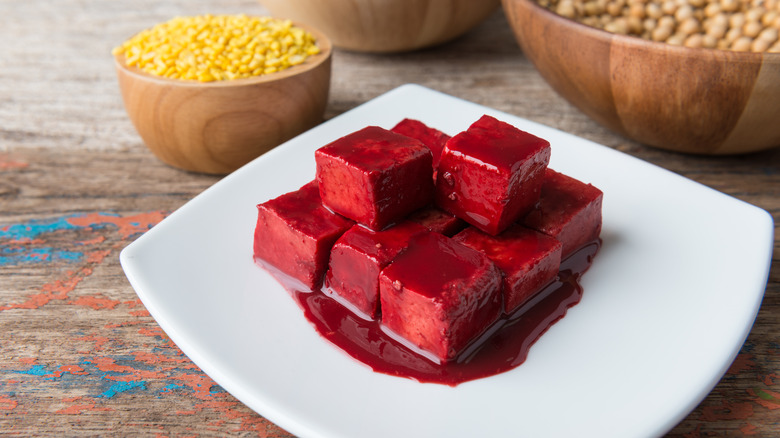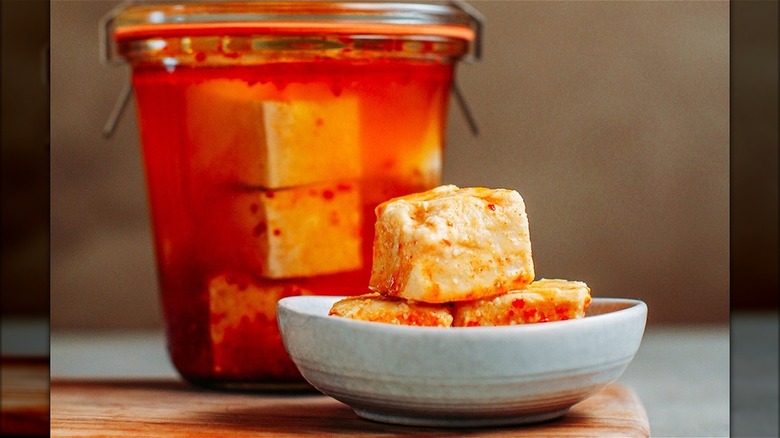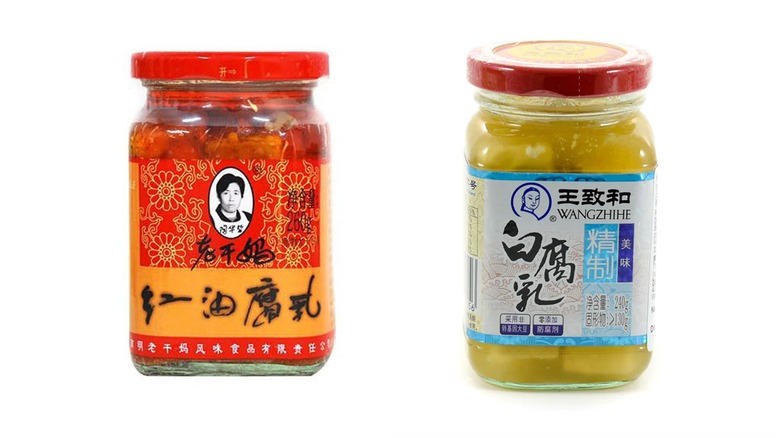The Vegetarian Ingredient That's A Perfect Substitute For Oyster Sauce
There's nothing quite like the taste of oyster sauce; it's rich, tangy, and exceptionally savory. However, for those who follow a vegetarian diet or have the misfortune of having an allergy to oyster sauce, it might feel like you're missing out. Luckily, one ingredient has gained critical acclaim from two-Michelin-starred chef Andrew Wong as a worthy substitute: fermented bean curd.
You may have heard of a Taiwanese soy paste that's a great alternative to oyster sauce, but while fermented bean curd is reminiscent of some of these flavors, it is utterly unique in appearance and taste. Also known as furu, or Chinese cheese, fermented bean curd can also typically include garlic, chili, wine, and vegetables, which all unite to create a meaty flavor similar to that of oyster sauce.
One may ask how an alternative to oyster sauce can resemble cheese. Surely they couldn't be more different? Well, the answer is in the umami taste. Fermented bean curd has fantastic layers of flavor that brighten and intensify the aromas in a dish – just like oyster sauce. Instead of feeling left out any longer, pick up a jar of fermented bean curd and see just how well you imitate the wonders of oyster sauce.
Tangy umami goodness
Furu, which is also written as fǔrǔ or 腐乳 in Mandarin Chinese, is traditionally used in congee or as a condiment. However, the ingredients' uses have expanded to see it added to just about any dish to boost the flavor. Although it may look like a protein substitute, one must recognize that a small amount goes a long way. This is not your ordinary tofu and should be regarded solely as a seasoning agent. Once retrieved from a jar, you can immediately recognize how the bean curd's texture is smooth and creamy, its odor pungent and salty. Once placed into a dish, it seems to effortlessly melt into the folds, disappearing in appearance just like oyster sauce and leaving behind a taste that lifts your dish to umami-mouthwatering perfection.
So how is it made? There are various methods to achieve the illustrious taste and texture of fermented bean curd. Still, generally, it incorporates some form of firm tofu that is either left to develop mold or coated in fungus. It then undergoes a process of fermentation with brine, rice wine, and spices. If you're a devoted vegetarian, you may have asked yourself, is the wine vegetarian? It's common for rice wine to be filtered through isinglass (fish bladder) or albumen (egg). For this reason, it's best to double-check the ingredients list on the fermented bean curd jar to ensure it's entirely vegetarian.
Its varieties and how to use it
There are plenty of varieties of furu, from sesame oil to chili-fermented variations; however, two of the most common versions are red and white. The red type, also known as hóngfǔrǔ, 紅腐乳, is made with red yeast rice, which gives it a dazzlingly vibrant red and purple color. It has a more robust flavor than the white variety, prominently featuring rich umami notes with a hint of sweetness. This type of fermented bean curd would go wonderfully in marinades and sauces. Yet it also magically works with water to form a delicious braising liquid for vegetables.
White fermented bean curd, otherwise known as 白腐乳 or báifǔrǔ, also works well in sauces, yet its most traditional application is usually in seasoning for congee or spread on fluffy and soft Chinese steamed buns. White fermented bean curd is regarded as a plain version of fermented bean curd, although some versions do find it brined in sesame or chili oil. Its taste is milder and lighter than the red furu, but its texture is usually firmer.
If you're ready to turn up your vegetarian dishes, consider adding a little fermented bean curd. The unbeatable flavor will have you wondering why you ever wanted oyster sauce in the first place.


